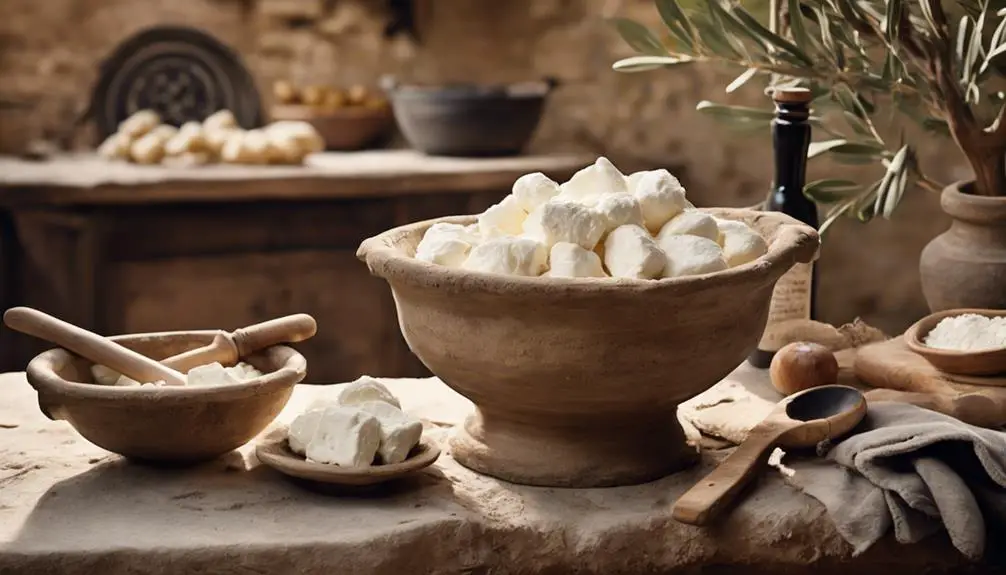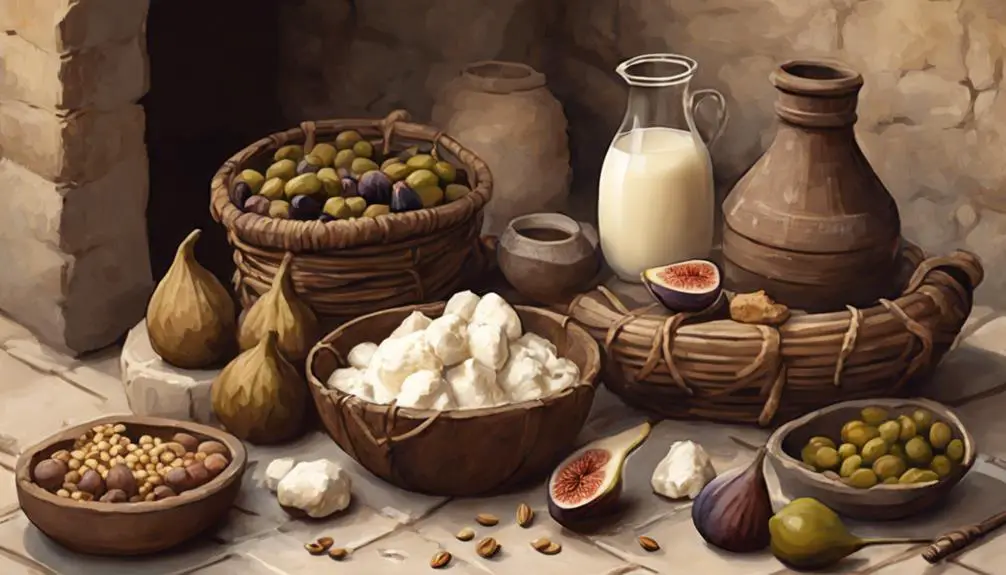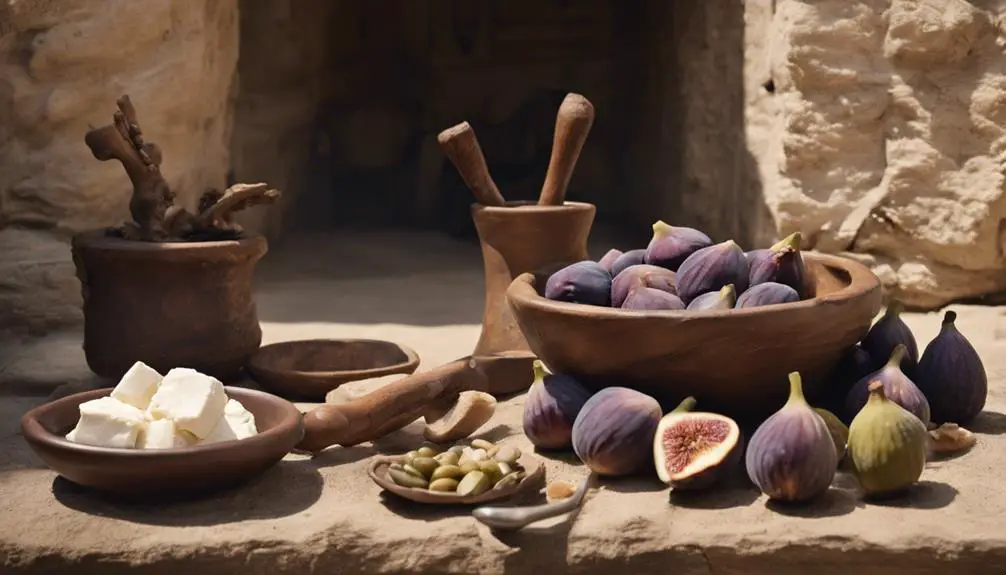This exploration of biblical curds reveals their deep cultural significance and the surprising ways they shaped ancient diets and rituals.

What Are Curds in the Bible
Did you know that references to dairy, including curds, appear over 50 times in the Bible? This might surprise you, considering the ancient context. Curds, essentially thickened milk, held a significant place in the diets and rituals of biblical times.
You're probably wondering how this staple food intertwines with the spiritual and daily life of those ancient societies. Unraveling the mystery behind biblical curds not only sheds light on historical eating habits but also opens a window into understanding the cultural and symbolic layers of these texts.
Let's explore what curds really meant to our ancestors and why their mention carries more weight than you might initially think.
Key Takeaways
- Curds in the Bible symbolize purity, prosperity, and a connection to pastoral life.
- Biblical references to curds exceed 50 times, underscoring their dietary and cultural significance.
- The production and consumption of curds were essential for nutrition and community well-being in ancient times.
- Curds embody deeper spiritual meanings, linking them to themes of purification and divine blessing.
Understanding Biblical Curds

To grasp the concept of curds as mentioned in the Bible, it's crucial to delve into the historical and cultural context of dairy products in ancient times. You'll find that the interpretation of 'curds' can significantly vary, leading to cultural discrepancies in understanding this term. Historical clarifications reveal that what ancient texts refer to as curds mightn't align with modern interpretations of dairy products.
In the Near Eastern and Mediterranean contexts, dairy played a pivotal role in the diet and religious practices, making the precise identification of terms like curds essential for accurate biblical exegesis. Scholars argue that these discrepancies stem from the evolution of dairy processing methods and the linguistic evolution of terms associated with dairy products. For instance, the Hebrew word translated as 'curds' in some Bible versions has been subject to debate among scholars, who suggest that its ancient meaning likely encompassed a broader range of dairy products than contemporary readers might assume.
Understanding these cultural and historical nuances is vital. It allows you to appreciate the significance of dietary references in ancient texts, providing a more profound comprehension of biblical narratives and the everyday lives of the people they depict.
The Making of Curds
Having explored the cultural and historical context of curds in biblical times, we now turn our attention to how these essential dairy products were traditionally made. Curds production in ancient times, while lacking the technological advancements of today, followed a process not wholly dissimilar from modern methods. This involved the coagulation of milk to separate the solids (curds) from the liquid (whey), a fundamental step in producing various dairy products.
The process of making curds can be understood through the following table:
Stage |
Ancient Method |
Modern Parallels |
|---|---|---|
1 |
Souring of milk naturally |
Use of specific cultures |
2 |
Coagulation by adding fig juice or rennet |
Use of rennet or acid |
3 |
Separation of curds from whey |
Mechanical separation |
4 |
Pressing and shaping |
Similar techniques, with advanced equipment |
This table underscores the continuity in curds production over millennia, highlighting both the ingenuity of ancient peoples and the enduring relevance of their dietary practices. While modern parallels have refined the process, the essential steps remain fundamentally unchanged, underscoring a deep connection between past and present dietary innovations.
Curds in Ancient Diets

Why were curds an integral part of ancient diets, and what does their ubiquity across various cultures reveal about their nutritional and societal importance? Dairy consumption, including curds, played a pivotal role in ancient nutrition, offering a rich source of essential nutrients such as proteins, calcium, and vitamins. This widespread inclusion of curds in diets underscores their fundamental value in sustaining health and supporting the growth of communities.
The nutritional aspects of curds are profound. They not only provided a compact, energy-rich food source but also contributed to bone health and the prevention of deficiency diseases, which were common in ancient times due to limited dietary diversity. Furthermore, the process of fermenting milk into curds added beneficial bacteria, improving gut health and enhancing the immune system.
Curds' role went beyond mere sustenance. They symbolized prosperity and were often associated with pastoral lifestyles, integral to many ancient societies. This universality of curds in ancient diets demonstrates their indispensable contribution to both the physical well-being of individuals and the economic stability of communities. Their continued prevalence in modern diets attests to their lasting legacy and ongoing nutritional relevance.
Symbolism and Significance
How did curds, beyond their nutritional value, come to embody profound cultural and spiritual significance in ancient societies? This transition from mere sustenance to a symbol laden with deeper meanings can be traced through various cultural interpretations and historical texts. In many ancient cultures, curds weren't just food but a metaphor for purity and simplicity. Their white color and simple production process made them an ideal symbol for these virtues.
Scholars have noted that in some societies, the process of curdling milk, separating the solid curds from the liquid whey, symbolized the separation of good from evil or the purification of the soul. This allegorical interpretation links the physical process of making curds with spiritual purification, illustrating how everyday activities were infused with spiritual meaning.
Modern parallels can be drawn with the way certain foods carry cultural and religious significance today, transcending their nutritional value to embody community identity, tradition, and beliefs. The enduring symbolism of curds, from ancient times to the present, reflects their role not just in diets but in the cultural and spiritual life of communities. This continuity highlights the rich tapestry of meanings foods can carry, influenced by historical context, cultural practices, and spiritual beliefs.
Curds in Biblical Narratives

In biblical narratives, curds are often mentioned, reflecting their significance in the daily and spiritual lives of ancient communities. This inclusion not only highlights their dietary importance but also serves to ground these stories in a specific cultural context. By examining historical recipes and dietary laws mentioned in biblical texts, scholars have deduced that curds were a staple food, rich in nutrients and essential for the survival of these communities.
The consumption of curds, as depicted in these narratives, wasn't merely a matter of sustenance but was imbued with symbolic meanings. For instance, the offering of curds to guests represented hospitality and respect, an act deeply ingrained in the social customs of the time. Such gestures are pivotal in understanding the interplay between food and the formulation of social bonds in biblical times.
Moreover, the preparation and sharing of curds can be seen as a reflection of the community's relationship with their land and livestock, indicative of a lifestyle that was closely tied to agriculture and pastoralism. Through this lens, curds emerge not just as a dietary element but as a cornerstone of ancient livelihoods, resonating with themes of sustenance, community, and divine blessing within the biblical narrative.
Frequently Asked Questions
How Do Modern Interpretations and Translations of the Bible Differ in Their Depiction of Curds?
You'll find that modern translations and interpretations of the Bible vary significantly in their depiction of curds due to translation challenges and shifts in cultural perception. Scholars analyze ancient texts and often struggle with conveying the exact dietary practices and food items, like curds, to contemporary audiences.
This results in diverse renderings across different versions, reflecting varied scholarly opinions and the evolving understanding of historical and cultural contexts surrounding biblical foods.
Are There Any Specific Health Benefits or Risks Associated With Consuming Curds as Described in Ancient Biblical Times?
You're exploring a timeless delicacy's essence, delving into curds' nutrition. These ancient treats, rich in calcium and protein, offer substantial health benefits.
However, for those with lactose intolerance, indulging might be a double-edged sword, leading to discomfort.
Scholarly analysis suggests that, despite the potential risks, the nutritional value of curds, as enjoyed since biblical times, remains undeniable, underscoring a delicate balance between nourishment and dietary caution.
How Have Curds Been Represented in Religious Artworks and Literature Outside the Bible, Particularly in Relation to Biblical Stories?
In exploring how curds have been depicted in religious artworks and literature beyond the Bible, you'll find they're often symbolically rich. Renaissance paintings, for example, frequently incorporate curds to signify purity or abundance, reflecting biblical narratives.
Literary symbolism, too, taps into these themes, using curds to highlight aspects of faith, provision, and purity. Scholars analyze these representations to understand deeper theological and moral messages conveyed through everyday elements like curds.
Can the Consumption and Production of Curds in Biblical Times Be Linked to Any Current Environmental or Ethical Concerns in Dairy Farming?
You may wonder if there's a link between ancient curd production and today's environmental or ethical concerns in dairy farming.
Indeed, drawing parallels to climate change and animal welfare, it's enlightening to analyze how these practices have evolved.
Historically, curd production was less intensive, but modern methods raise questions about sustainability and ethics.
Reflecting on the past could shed light on how to address these challenges in a manner that's both scholarly and analytical.
Are There Documented Rituals or Traditions in Contemporary Religious Practices That Still Involve the Use of Curds, Inspired by Biblical References?
You're exploring whether contemporary religious practices still include curd ceremonies, inspired by biblical references.
It's fascinating to note that, indeed, several traditions maintain the use of curds, attributing spiritual symbolism to them. These practices often reflect ancient beliefs and rituals, signifying purity, fertility, or blessing.
Scholars and religious texts reference these ceremonies, highlighting their continuity and evolution within modern religious observance, thus underscoring the enduring significance of curds in spiritual contexts.
Conclusion
In conclusion, curds in the Bible, much like a beacon in the night, illuminate the dietary habits and cultural significance of ancient times. Through an analytical lens, it's evident that these dairy products weren't just food but symbols of prosperity and purity (Gen 18:8).
As you've seen, their inclusion in narratives and laws (Lev 7:22-27) underscores a multifaceted role in both daily life and spiritual metaphor. Thus, biblical curds offer a rich tapestry of cultural and religious insights, bridging the past with scholarly inquiry today.



Sign up